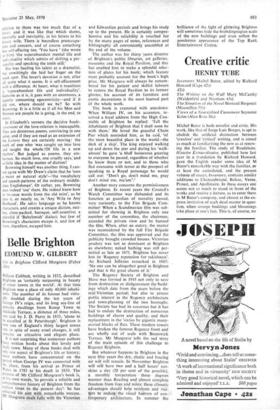Belle Brighton
EDMUND W. GELBERT
Life in Brighton Clifford Musgrave (Faber I20s) William Cobbett, writing in 1832, described Brighton as 'certainly surpassing in beauty all other towns in the world'. At that time Brighton was a. place of only 40,000 inhabi- tants. The number of its houses had virtu- ally doubled during the ten years of George IV's reign, and its long sea-line of Princely dwellings from Kemp Town to Adelaide Terrace, a distance of three miles, was said by J. D. Parry in 1833, 'alone to be equalled at St Petersburgh'. Brighton is now one of England's thirty largest towns and, in spite of many cruel changes, it still remains an attractive and elegant place. It is not surprising that numerous authors have written books about this lovely and lively town. Many of these books deal with only one aspect of Brighton's life or history; most authors have concentrated on the Period when George IV was connected with the place, from his arrival as Prince of Wales in 1783 to his death in 1830. The Purpose of Mr Clifford Musgrave's book is, in his own words, 'to provide a reliable and comprehensive history of Brighton from the earliest times to the present day': he has achieved his aim with remarkable success. Mr Musgrave deals fully with the Victorian and Edwardian periods and brings his study up to the present. He is certainly compre- hensive and his reliability is vouched for by the many pages of notes, references and bibliography all conveniently assembled at the end of the volume.
The author was for thirty years director of Brighton's public libraries, art galleries, museums and the Royal Pavilion, and this has enabled him to make a splendid selec- tion of plates for his book; which feature must probably account for the book's high price. Mr Musgrave will always be remem- bered for his patient and skilful labours to restore the Royal Pavilion to its former glories; his account of its furniture and exotic decorations is the most learned part bf the whole work.
The book is crammed with anecdotes. When William IV, on his accession, re- ceived a loyal address from the High Con- stable of Brighton he replied: 'Tell the inhabitants of Brighton that I shall soon be with them.' He loved the graceful Chain Pier which reminded him, as he said, 'of the most beautiful place in the world—the deck of a ship'. The king enjoyed walking up and down the pier and during his 'walk- abouts' he gave 'a bluff boisterous greeting to everyone he passed, regardless of whether he knew them or not, and to those who fled overcome with terror at the prospect of speaking to a Royal personage he would call out: "Don't go, don't mind me, pray don't mind me, ma'am".'
Another story concerns the permissiveness of Brighton. In recent years the Council's Watch Committee was disbanded and its function as guardian of morality passed, very curiously, to the Fire Brigade Com- mittee! When a Scandinavian film was sub- mitted for showing in Brighton only one member of the committee, the chairman, attended the private view and he banned the film. When, after an outcry, the matter was reconsidered by the full Fire Brigade Committee, the film was approved and the publicity brought crowded houses. Victorian prudery was not as dominant at Brighton as elsewhere; naked bathing was still per- mitted as late as 1871. Brighton has never lost its 'Regency reputation for rakishness'. As Richard Jefferies remarked in 1885: `No one can be altogether good in Brighton and that is the great charm of it.'
The Regency Society of Brighton and Hove was formed in 1945 not only to save from destruction or disfigurement the 'build- ings which date from the years before the mid-Victorian period; but also to arouse public interest in the Regency architecture and town-planning of the two boroughs. The Society has had its successes but it has had to endure the destruction of numerous buildings of charm and quality, and their replacement in the 'sixties by gigantic many- storied blocks of flats. These modern towers have broken the famous Regency front and are wholly out of scale with Brunswick Terrace. Mr Musgrave tells the sad story of the main episode of this challenge to Regency Brighton.
But whatever happens to Brighton in the next fifty years the dry, elastic and bracing air will still remain. In November Brighton will still have two and a half hours' sun- shine a day (28 per cent of the possible), a monthly temperature three degrees warmer than Reading and almost complete freedom from fogs and mists: these climatic advantages should help residents and visi- Vrs to endure the visual horrors of con- temporary architecture, In summer the brilliance of the light of glittering Brighton will sometimes hide the brobdingnagian scale of the new buildings and even soften the ponderous appearance of the Top Rank Entertainment Centre;


































 Previous page
Previous page